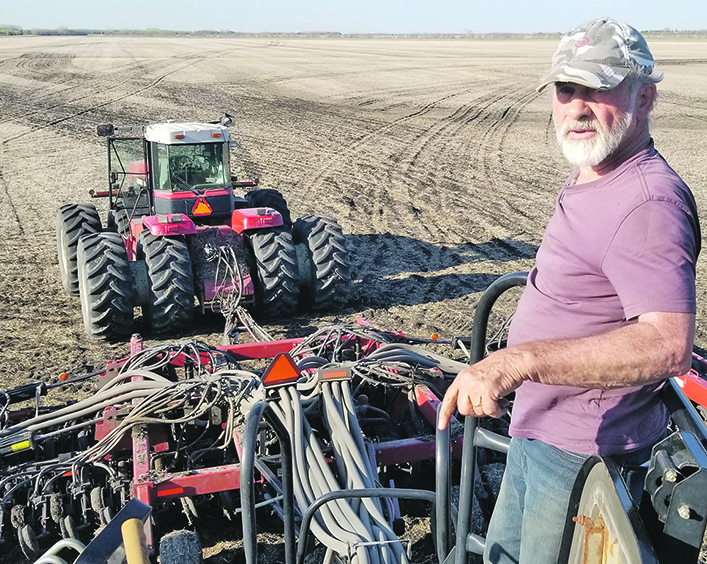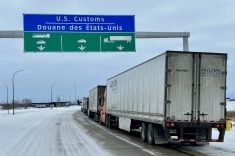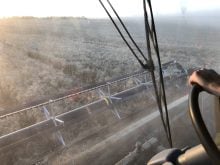Our 1,000 acre farm is 40 kilometres southeast of the Versatile factory.
The farm is not a crazy amount of work, which allows me to do other things beside farm. The size of the farm doesn’t let me buy much new equipment. The last new implement I bought was a canola swath roller in 1997.
I have obtained a collection of all kinds of farm equipment, supporting Canadian-made, and in particular Manitoba-made, farm equipment. A friend who farmed with Versatile tractors in the 1980s predicted a bright future for Manitoba implement manufacturers. However, the 1980s were financially difficult for farmers and manufacturers, with barley sometimes below $2 per bushel and interest rates sometimes more than 17 percent.
After these difficult years, the Winnipeg tractor factory continued as Ford New Holland after Ford bought both Versatile and Sperry New Holland.
The black, yellow, red Versatiles turned into blue Fords.
When CaseIH and New Holland merged about a dozen years later, they had too many models of tractors. Consequently, John Buhler bought the Winnipeg tractor factory and put the colour scheme of his Farm King Auger on Versatile tractors.
Since then, it has been sold to Rostselmash. Black, red and yellow can be found on some newer Versatiles.
This is the story of how I got to own four Versatiles that were made mostly in Winnipeg, but none displayed the Versatile name as the primary name.
None have the old or the very new red, yellow, black traditional Versatile colors.
My blue Ford 9030 bidirectional is a handy tractor once I got used to it. It works like an extension of the human arm and hand. The bidirectional hydrostatic tractor was introduced in 1977, and was different to any other loader tractor available at the time.
Why did bidirectional tractors disappear? Who has the rights to it?
The TA78 New Holland pulltype combine is a dual rotor machine with a transverse feeding cylinder/beater. The predecessor Versatile 2000 went to market about 35 years ago. The double rotor was later introduced by John Deere in 2019 and is used in Claas combines.
When pulltype combines were popular, most tractors had manual, non-synchronized transmissions. It was great fun to shift to the next gear at full engine RPM. By the time power shift tractors became common, pulltype combines got parked permanently in the tree lines.
My Cat 35 Challenger tracked tractor is basically a Genesis with tracks and a Cat engine. It was sold in Europe featuring the Claas green, orange, cream colour scheme. What a super tractor and fun to drive. My Buhler 2425 is the newest addition to the collection. It still articulates in a similar way as the Versatile D100 from 1966.
I used my Buhler 2425 to pull my Torrmaster disc drill and a Flexi-coil plastic air tank. My introduction to Torrmaster was in 1996. I was working on a farm in Kazakhstan in co-operation with Flexi-coil, Macdon, Dow, Agrevo, and the Canola Council of Canada.
We visited another farm hundreds of kilometres away from where we lived. In the yard, they had a Torrmaster air seeder. To this day, I don’t know how Vic Zacharias got one of his air seeders to Kazakhstan just shortly after the demise of the Soviet Union.
The thing I like most about all this farm equipment is that I own it. No bank will repossess it. More importantly I don’t have to make lease payments, and then after a few years of lease payments give it back to the people who own it. What I cannot repair myself is fixed locally by South East Farm Equipment.
John Buhler once said he always wanted to own a tractor company. And he did. As farmers, some of us have owned shares in Co-op Implements. We have owned parts of Manitoba Pool Elevators, Saskatchewan Wheat Pool and Alberta Wheat Pool.

About 25 years ago, I owned shares in a company that was to produce glyphosate at a lower price. The company never got going as the price of glyphosate decreased, so maybe the goal of the instigators was achieved.
The company paid back the investment. About 10 years ago, we owned shares in the Farmers Edge soil lab, a short-lived investment.
Farmers rent land from landowners, pay lease payments on equipment they don’t own and may be restricted on the type of implement repairs they’re allowed.
What if there was a tractor company that might be worth $200 million? It would take 10,000 farmers to invest $20,000 each to own a company like that. Probably will never happen. But I assume that somewhere in my registered retirement savings plan I own some shares in Deere, Case, or Agco. Which is probably as close to owning a tractor company as I will ever get.
John Deere has a combine factory in China where they produce the John Deere 1076, which I saw in Mongolia while working there.

















